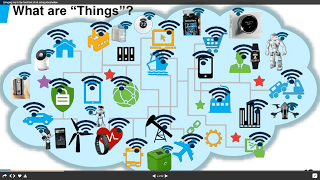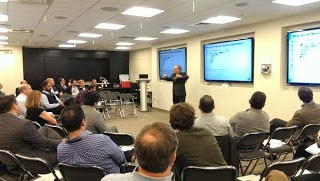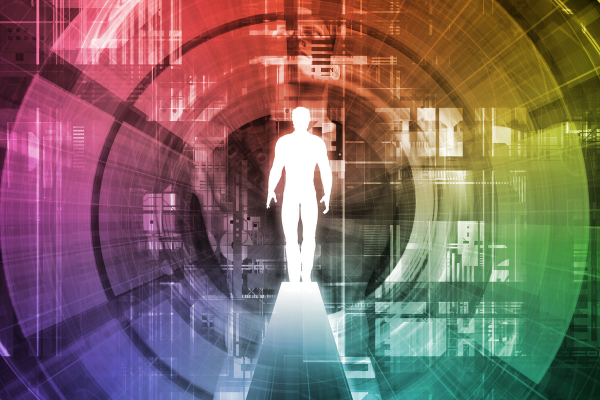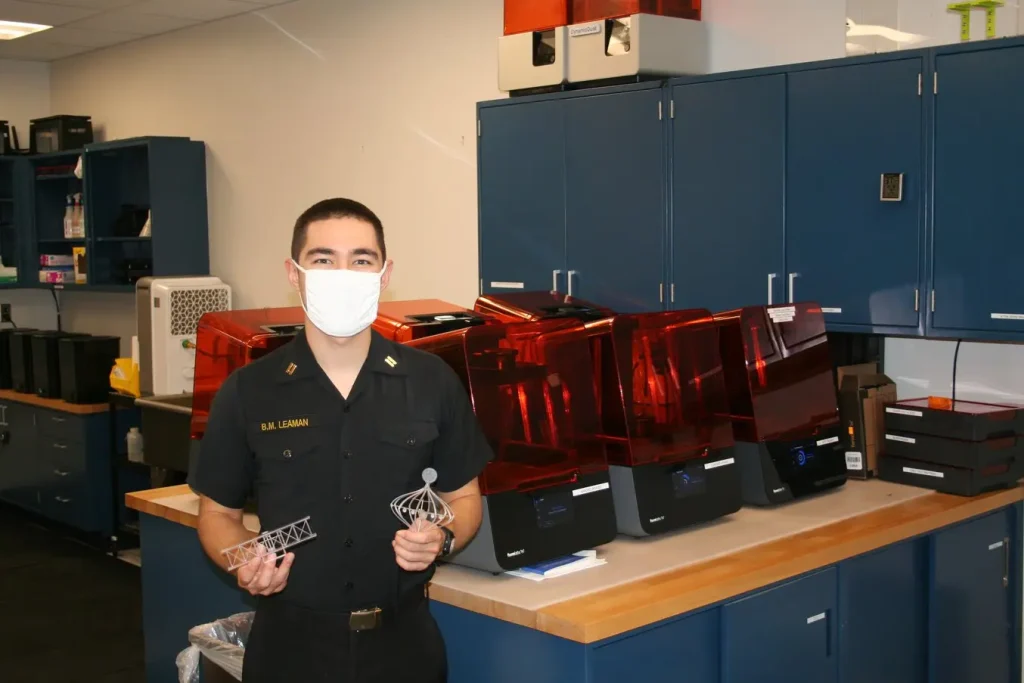April 29, 2015
IoT Roundtable: Keeping MA at the forefront
of IoT
of IoT
Back in
February, MassTLC’s IoT Steering
Committee met to develop a mission, which is bringing together everyone
within the Massachusetts’s IoT ecosystem to make us THE global hub of IoT. And
on April 29th, roughly 50 IoT enthusiasts joined MassTLC at Pegasystems in Cambridge for an open
forum to start the conversation on how to make this a reality.
February, MassTLC’s IoT Steering
Committee met to develop a mission, which is bringing together everyone
within the Massachusetts’s IoT ecosystem to make us THE global hub of IoT. And
on April 29th, roughly 50 IoT enthusiasts joined MassTLC at Pegasystems in Cambridge for an open
forum to start the conversation on how to make this a reality.
Lead by
Setrag Khoshafian, Chief Evangelist and VP of BPM Technology at Pegasystems, the forum kicked off with a
landscape – highlighting that is beyond technology. It is about adding value and
changing lives.
Setrag Khoshafian, Chief Evangelist and VP of BPM Technology at Pegasystems, the forum kicked off with a
landscape – highlighting that is beyond technology. It is about adding value and
changing lives.
Setrag discussed some of the ‘things’,
spanning from watches to shopping carts to lightbulbs to windmills to engines,
robots, or any piece of machinery at any home, factory, hospital, or other
institution. And interestingly the
social networks highlight that IoT’s strongest in the wearables and connected
home markets, but the real markets in terms of revenue include manufacturing
and transportation.
spanning from watches to shopping carts to lightbulbs to windmills to engines,
robots, or any piece of machinery at any home, factory, hospital, or other
institution. And interestingly the
social networks highlight that IoT’s strongest in the wearables and connected
home markets, but the real markets in terms of revenue include manufacturing
and transportation.
While there are many reference models to
build an IoT strategy, Setrag focused on the IoT World Forum’s which top-down
approach starting at Collaboration and Processes – the people and business
process) and ending at the Physical Devices and Controllers – the things.
build an IoT strategy, Setrag focused on the IoT World Forum’s which top-down
approach starting at Collaboration and Processes – the people and business
process) and ending at the Physical Devices and Controllers – the things.
In the end,
we know that IoT does have hype, but it’s not just the hype. It’s real, it’s
happening.
we know that IoT does have hype, but it’s not just the hype. It’s real, it’s
happening.
Below is a
list of questions, answers, insights that came from the forum. Rather than summarize,
I’ve done my best to synthesize. The bold subheadings are the topics for each discussion
block.
list of questions, answers, insights that came from the forum. Rather than summarize,
I’ve done my best to synthesize. The bold subheadings are the topics for each discussion
block.
Why Boston?
- We have dense segregated stake holder tech communities.
- Our strong educational system around we have
here. - It’s a financial hub. MA leads in investments in
IT infrastructure. Some of the largest investments in M2M and IoT space have
been here in Boston. - We have the main IoT infrastructure players
located in region. - IoT is a comprised of different technologies: software,
networking, ALM, etc. and Boston has all of these. - The environment is right because we have the financial,
operational, technology all here. - Robotics is huge in Boston. And robotics and IoT
and data go together perfectly. When you put IoT and robotics together you can
take a leap to another level. - Can Massachusetts just become the
global hub of IoT generically? Does having all of the key sectors here make us
stand out more than other areas? How do we really bring all of these things
together and then showcase them together? - We need investments on the backend to support
IoT. - In terms of vertical industries the medical
industry here could provide a huge lab to work on IoT. - We are in close proximity to Europe and other international
regions where IoT/M2M is prevalent. - Innovation happens at the boundaries. We have a
lot of multifaceted businesses that are all on the boundaries of innovation
(healthcare, robotics, etc) so we have a unique foundation to start this.
What are the industries or domains we
should be focusing on? Or should we?
should be focusing on? Or should we?
- Wearable and ingestibles are both areas to watch
out for in the healthcare industry. - Boston is such a center of healthcare both on the
research and practitioner side it is an obvious place we can focus. - A question
from an audience member to the group: What is the objective of there being
focus? – – All innovation happens when a company or group
of people or an entrepreneur takes a lead and does something. It’s about going
after an opportunity. It’s not about choosing a focus.- – Opposing
view: We can certainly influence the focus by providing direction in the
incubators, accelerators, investments, in certain areas.
- MassTLC can help be the petri dish to help drive
focus areas and ID the huge opportunity markets such as healthcare and
robotics. - We need to spur discussion between big industry
and government – such as they are doing in Singapore and Dubai – where they are
building smart cities from scratch. We in the US are retrofitting cities w/
IoT. But the government needs to make investments. If we’re an innovation hub
then the government needs to be part of the ‘it takes a village’ group. It
should not take four years to deploy smart meters.
How can we effectively work together? How
can such a diverse group be effective together?
can such a diverse group be effective together?
- One way is to make sure we all understand what
each other does. And then we need to know what we are asking from one another.
Getting a deep understanding of how we can work together is critical. - ID some areas that everyone agrees on. What are
the common areas? - The success is knowing and making all the parts
of the ecosystem available. VCs and entrepreneurs to technologists, customers,
partners. You need to bring everyone together. - We need to create an ecosystem for idea sharing.
- Gain an understanding of the technology
landscape both horizontally and vertically. Then assess where we are strong and
where we have gaps. If we want to really have leadership in that area we need
to play to our strengths and/or fill in the gaps where we aren’t strong. - Put together a series of discussions with
vertical leaders (from DoT or healthcare institution) to provide insights on the
problems they are facing. - It is important that Boston itself become a
showcase of this technology to actually be the leader of the technology. - Can we have a focal point, such as gathering
around the Olympics in Boston? And then bring stakeholders together to
collaborate on how to create a smart city in time for the Olympic Games. You
need a focal point if you really want to bring together to work effectively.
What are customers asking for and how can
we support them as a team? And what aren’t they asking for? This can be B2B,
B2C, internal enterprise, partners, government, etc.
we support them as a team? And what aren’t they asking for? This can be B2B,
B2C, internal enterprise, partners, government, etc.
- Customers want to know how to monetize. You
monetize the service that the IoT provides. - They want to know what investments they can make
today that won’t be obsolete in a couple of years. So what platforms they can
invest in that enables them to build on top of it and continue leveraging the
platform for some time. - What people want are ways to get things done.
Technologists can use their resources to make that happen for them.
What have you seen in IoT
disruptions/innovations? Trends you have seen?
disruptions/innovations? Trends you have seen?
- It’s about coming up w a platform to leverage
the data that people can make money off of. – – One obvious example is jet engines. The guys
that own the airplanes don’t own the engines. – – The cities don’t own the parking meters. – – The houses w/ the solar panels don’t own the
panels.
What are the most serious challenges?
- Security
- Privacy / governance
- Skills gaps
- Who owns the data? What happens when the company
goes under and the information is stored in the cloud. We need to work w/ the
govt to create the laws for the owners. - Understanding what infrastructure, societal, or
governmental situations that will impede progress. Can we get ahead of this?




